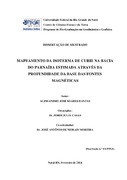Please use this identifier to cite or link to this item:
https://repositorio.ufrn.br/handle/123456789/19944| Title: | Mapeamento da isoterma de Curie na Bacia do Parnaíba estimada através da profundidade da base das fontes magnéticas |
| Authors: | Dantas, Alessandro José Soares |
| Advisor: | Casas, Jordi Julià |
| Keywords: | Gradiente geotérmico;Fluxo térmico;Análise espectral;Isoterma de Curie;Bacia do Parnaíba;Gravimetria;Magnetometria |
| Issue Date: | 22-May-2014 |
| Publisher: | Universidade Federal do Rio Grande do Norte |
| Citation: | DANTAS, Alessandro José Soares. Mapeamento da isoterma de Curie na Bacia do Parnaíba estimada através da profundidade da base das fontes magnéticas. 2014. 35f. Dissertação (Mestrado em Geodinâmica e Geofísica) - Centro de Ciências Exatas e da Terra, Universidade Federal do Rio Grande do Norte, Natal, 2014. |
| Portuguese Abstract: | Localizada no limite oeste do nordeste brasileiro, a Bacia do Parnaíba é uma bacia intra-cratônica produtora de petróleo. O presente estudo tem como objetivo caracterizar sua estrutura térmica, utilizando dados aeromagnéticos e gravimétricos. Com isso, foi utilizado à técnica de análise espectral em dados magnéticos da bacia, para mapear a profundidade dos corpos magnéticos e assimila-los à profundidade da isoterma de Curie da magnetita, com o interesse de mapear o seu gradiente geotérmico. Utilizando a técnica da análise espectral, foi possível mapear a Superfície da base das fontes magnéticas (SBFM), superfície que delimita a profundidade na qual ainda ocorre magnetização da magnetita. Na Bacia do Parnaíba a SBFM apresentou profundidades em torno de -20,5 e -28,5 km. Paralelamente para servir como gabarito para a SBFM, foi feita uma inversão dos dados magnéticos utilizando a técnica de inversão do vetor de magnetização (MVI), que demonstrou ser consistente com a SBFM. Além disso, a SBFM se correlaciona positivamente com a profundidade da Moho que foi estimada através de dados gravimétricos do satélite GOCE (Gravity Field and Steady-State Ocean Circulation Explorer). Supondo que a SBFM coincida com a Isoterma de Curie da Magnetita (ICM), superfície na qual a magnetita ( ) perde as suas propriedades ferromagnéticas, foi possível estimar o gradiente geotérmico. Deste modo, o gradiente geotérmico na bacia apresentou valores entre 19,2 e 26,5 . Pelo gradiente geotérmico foi possível estimar o fluxo térmico na bacia utilizando uma condutividade térmica de 2,69 . Deste modo, foi encontrado um fluxo térmico na bacia variando entre 51,6 e 71,3 , que é consistente com valores encontrados em outros trabalhos de fluxo térmico da América do Sul. Adicionalmente foi possível estimar a espessura da litosfera através de uma relação empírica entre esta e a Isoterma de Curie da Magnetita, encontrando valores entre -65,8 e -89,2 . Através destas informações, propomos que a estrutura térmica da bacia do Parnaíba está sendo influenciada por uma anomalia térmica profunda. Esta anomalia tem aquecido a litosfera sob a bacia e tem resultado em valores relativamente finos III para a espessura litosférica e valores relativamente altos para o fluxo de calor na superfície. A origem desta anomalia não é clara, mas a correlação entre a profundidade de Curie e a topografia da Moho, sugere que processos tectônicos de extensão poderiam ter influenciado na geração da mesma. |
| Abstract: | Located on the western edge of the Brazilian northeast, the Parnaíba Basin is an intra cratonic basin with oil production. This study aims at understanding its genesis and evolution, using aeromagnetic and gravity data. We used the spectral analysis of aeromagnetic data to map the depth to the bottom of the magnetic sources in order to assimilate this depth with the depth of the Curie isotherm, and infer the geothermal gradient. Using the spectral analysis technique, we succeeded in mapping the surface of the depth to the bottom of magnetic sources (SBFM), which marks the depth that occur magnetization. In the Parnaíba Basin the SBFM presented depths around -20,5 and -28,5 , which was consistent with an inversion of the same dataset using the technique of Magnetization Vector Inversion (MVI). Furthermore, SBFM topography correlates well with Moho depth, which was estimated from satellite gravimetric data from the GOCE mission (Gravity Field and Steady-State Ocean Circulation Explorer). Assuming that SBFM coincides with the Curie isotherm of magnetite (ICM), defined as the surface at which magnetite ( ) looses its ferromagnetic properties, it was possible to estimate the geothermal gradient. The geothermal gradient in the basin showed values between 19.2 and 26.5 , allowing to estimate the heat flow for the Parnaíba basin after assuming a conductivity of 2.69 . The resulting heat flow values ranged between 51.6 and 71.3 , which is consistent with values found in other works throughout the South American continent. Lithospheric thickness using an empirical relationship, finding values between -65.8 and -89.2 . We propose that thermal structure of Parnaíba basin is influenced by a deep thermal anomaly. This anomaly has heated the lithosphere beneath the basin and has resulted in relatively thin values for the lithospheric thickness and relatively high surface heat flow values. The origin of the anomaly is not clear, but the correlation between Curie depth and Moho topography, suggests that tectonic extension processes could have played a role. |
| URI: | https://repositorio.ufrn.br/jspui/handle/123456789/19944 |
| Appears in Collections: | PPGG - Mestrado em Geodinâmica e Geofísica |
Files in This Item:
| File | Description | Size | Format | |
|---|---|---|---|---|
| AlessandroJoseSoaresDantas_DISSERT.pdf | 34,32 MB | Adobe PDF |  View/Open |
Items in DSpace are protected by copyright, with all rights reserved, unless otherwise indicated.

